In 2016, the mayor and city officials committed to doubling the manufacturing capacity of the East New York Industrial Business Zone, which they say would help create 3,900 local jobs there. But five years later, neighborhood leaders say the area has stagnated.
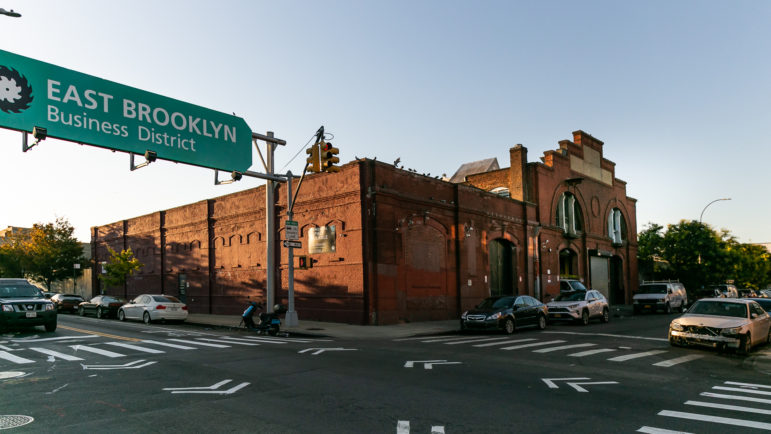
Adi Talwar
The intersection of Liberty and Sheffield avenues in East New York, Brooklyn.After 64 years in the East New York Industrial Business Zone (IBZ), Brooklyn’s last union lighting shop is packing up and moving to Long Island.
Legion Lighting’s 40,000-square-foot warehouse on Glenmore Avenue is now on the market, with owner Michael Bellovin fielding offers for around $11 million as he plans a reluctant move to Patchogue.
“It’s a common story with multi-generational businesses: The property becomes more valuable than the business,” said Bellovin, whose father Sheldon co-founded the Local Development Corporation (LDC) of East New York, a group that coordinates business training and development in the IBZ. “The offers on the building are significant enough to catch the attention of the rest of the family members that own the property.”
The move will be a blow for the East New York IBZ, a transit-rich 57-block span bounded by Atlantic Avenue to the north and Sutter Avenue to the south, with Sheffield Avenue and Powell Street forming the rough east-west edges. The IBZ continues for about six blocks south along Van Sinderen Avenue. The area was supposed to experience a boom in the wake of a nearby neighborhood-level rezoning in 2016, Mayor Bill de Blasio said at the time. After sealing approval for the controversial land use plan, de Blasio and city officials introduced an additional round of commitments intended to double manufacturing capacity, add 3,900 jobs to the IBZ and “keep East New York at the forefront of our industrial economy for generations to come.”
But more than five years later, no one is keeping track of the number of new jobs in the IBZ. Local entrepreneurs and their advocates say the area is nowhere near the business and employment goals laid out by the city. In fact, says current LDC of East New York Director Bill Wilkins, the IBZ probably lost jobs over the past few years—a trend accelerated by the COVID pandemic, which hindered local employers, like the bus companies operating out of large lots in the heart of the district.
The de Blasio Administration has made good on some of its IBZ-related commitments, but the city’s Planning Department and Economic Development Corporation (EDC) blame the failure to fulfill the 3,900-job projection on various factors, above all a stalled plan to rezone nearby Broadway Junction for higher density commercial use. After several meetings with local community boards and civic groups, the EDC in 2019 released a document outlining a plan to turn the busy area into a transit hub and mixed-use economic center. Then-Councilmember Rafael Espinal resigned less than six months later, leaving the district unrepresented for nearly a year and complicating the city’s ability to move forward with the plan, officials said.
East New York business owners, workers and activists say the failure is just the latest broken promise in a decades-long disinvestment campaign. They say city agencies have not prioritized the IBZ, which has become home to a disproportionate number of homeless shelters and storage facilities over the years—not exactly economic drivers or sources of decent-paying jobs.
“We need economic justice in East New York,” said Albert Scott, chair of the East New York Homeowners’ Association and a board member for the East New York Community Land Trust (CLT). “They said 3,900 jobs. They were very clear on that.”
Just under a third of residents in the neighborhood and nearby Starrett City live in poverty, according to the city’s most recent community health profile, published in 2018. More than half are rent-burdened, meaning at least 30 percent of their income goes to housing. Those numbers, along with unemployment, have likely surged since the pandemic began.
With a new mayor coming into office, Scott and other local leaders see an opportunity for the East New York IBZ to generate more dynamic industries and create good-paying jobs—so long as the city makes that a priority.
“We have a grand vision for economic justice in East New York,” Scott said.
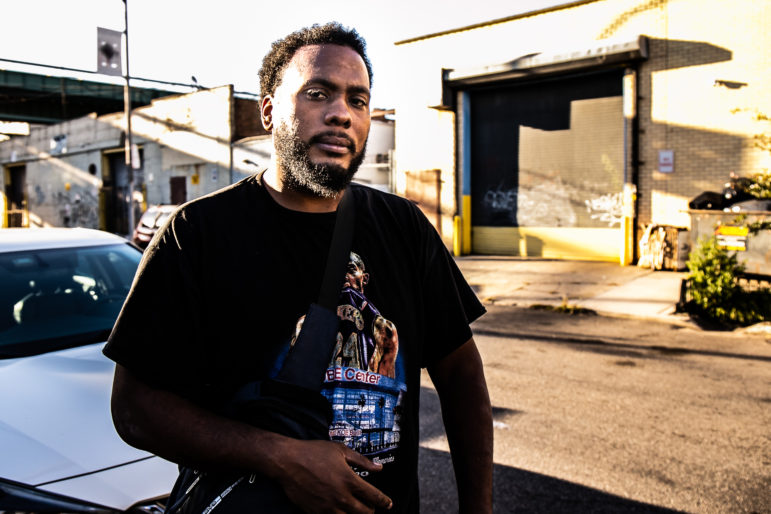
Franklyn A. Mena, one of the founders of Universe City in the East New York IBZ. 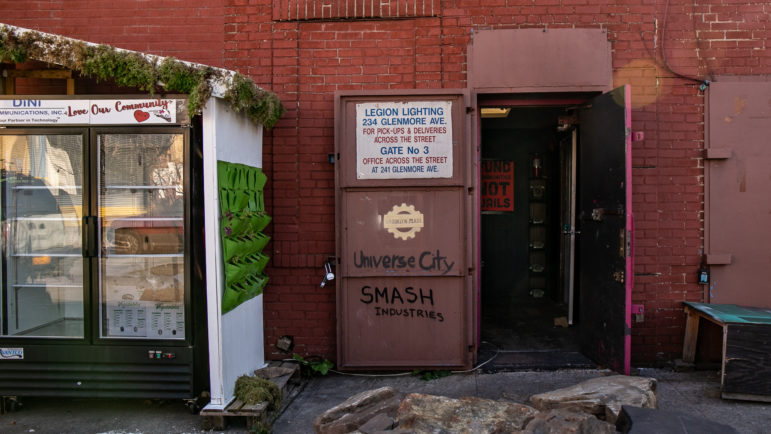
Entrance to Universe City, a business incubator and aquaponic urban farm, in East New York, Brooklyn. 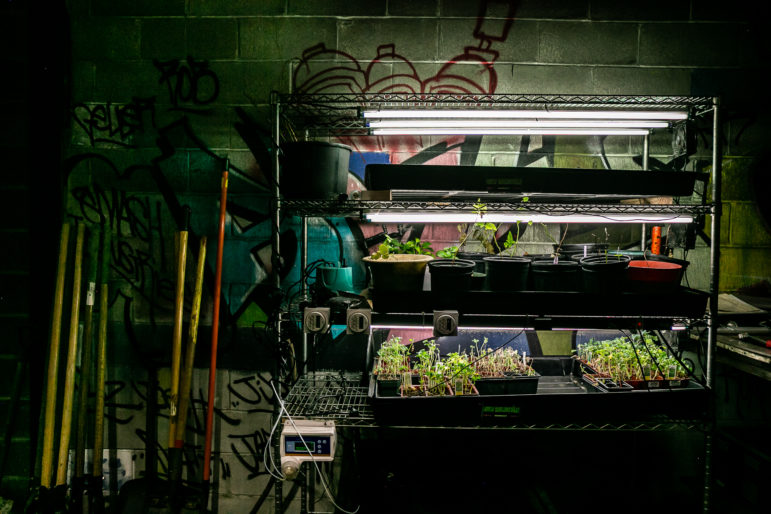
Inside Universe City, where workers hope to grow and distribute food to the East New York community. 
Model subway cars at Universe City in the East New York IBZ. 
Another room in Universe City.
‘Long-lasting, sustainable jobs’
Across the street from Legion Lighting, Franklyn Mena has co-founded a model for that sort of community-minded growth.
In January 2020, Mena and three others launched Universe City, an urban farm and aquaponics system cultivating fish and produce inside a Glenmore Avenue warehouse. Their goal is to grow and distribute food throughout the local community, a mission that took on even greater urgency as the COVID crisis fueled food insecurity in East Brooklyn. During the pandemic, Universe City opened a community fridge stocked with vegetables and stepped up food distribution in East New York and Brownsville.
“The idea behind Universe City is we want to be a food port and food hub for the community, with storage, an industrial kitchen, places where people can cook and distribute food,” Mena said during a tour of the industrial space. “These are long-lasting, sustainable jobs with lots of opportunities for small and big businesses.”
Mena envisions the large Legion Lighting warehouse across the street as the future home of the food hub, a place where East New York’s many community gardeners can store their crops, local chefs can prepare and package their creations, and even large conglomerate food distributors can rent space for storage along their delivery routes.
But so far, Bellovin, the Legion Lighting owner, hasn’t heard from potential buyers likely to consider that kind of use for the site, which is zoned for manufacturing. He said he has received offers from a low-income housing developer that he suspects would open a homeless shelter, as well as an e-commerce company. He has also heard from a portable toilet company and a plastic shopping bag manufacturer, two firms that could actually bring some decent-paying jobs to the area.
Brother Paul Muhammad, a member of the East New York Coalition for Community Advancement Steering Committee and Brooklyn Community Board 5, said he hasn’t seen the city engage in more innovative planning or business development in the IBZ.
To Muhammad, a recently completed hotel a few blocks away has come to symbolize the problems. He and other members of Community Board 5 suspect the hotel will quickly be converted into a homeless shelter. The LLC behind the project did not provide a response for this story.
The IBZ is already home to at least six storage warehouses and at least four homeless shelters, according to members of the East New York Coalition for Community Advancement, a group of overlapping civic organizations and community leaders. The city’s Department of Homeless Services does not publish shelter addresses, though the city’s EDC says no new shelters have opened in the IBZ since the nearby rezoning passed. The agency also said no new storage facilities have opened since 2017.
Muhammad said the area has stagnated, despite the city’s earlier pledges.
“They promised the rezoning would bring economic rejuvenation to the area,” Muhammad said, as he approached the former home of Piel’s Beer on Liberty Avenue, about a block from the hotel. The block-long brewery, which closed in 1973, once filled the whole neighborhood with the smell of beer being made.
“It used to smell like cornbread,” Muhammad added.
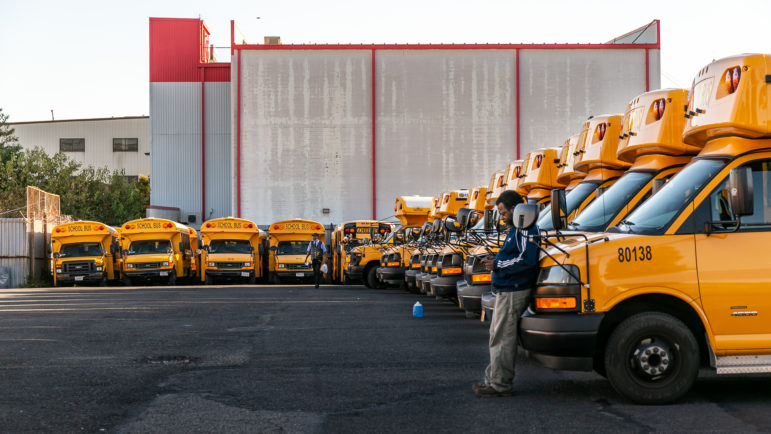
Adi Talwar
One of Consolidated Bus Transit’s many parking lots in East New York, Brooklyn.A workforce blueprint for future rezonings
In an April 2016 letter to then-Councilmember Rafael Espinal, Deputy Mayor Alicia Glen touted an ambitious plan to “densify and strengthen” the IBZ after commencing the residential rezoning nearby. A $16.7 million municipal investment had the potential to “attract 250 new companies to the IBZ, including specialty and construction trades, thereby bringing approximately 3,900 new quality jobs to the area over the next decade,” she wrote.
Those investments would also add 2.7 million square feet of manufacturing space and connect more local residents to jobs in the IBZ by “catalyzing better activation of underutilized properties,” the mayor’s office wrote in a buzzword-heavy press release three months later.
Alexa Sloan, a community organizer with the Cypress Hills Local Development Corporation (LDC), said the EDC has not identified a single job created through the $16.7 million investment, however.
“We’re fighting for the 3,900 jobs,” Sloan said, echoing what Cypress Hills LDC Director Michelle Neugebauer told City Limits last year (“We’re four years in and nobody has reported on one job being created,” Neugebauer said then.)
The city did not respond directly to City Limits’ inquiries about how many jobs have been created, how many new businesses have opened and how much additional manufacturing space has been added in the IBZ since the rezoning was approved.
It’s also unclear how many businesses are now operating in the IBZ. There are at least 95 companies in and around the zone, according to a directory maintained by the East Brooklyn Business Improvement District (EBBID), which helps local firms with regulation compliance, IBZ certification and financing. The group is co-led by Wilkins and shares resources with various organizations that make up the East New York Coalition for Community Advancement. There were 6,265 employees at more than 100 businesses in 2019, according to the EBBID website.
A 2016 East New York IBZ study commissioned by the EDC said there were likely 250 businesses with 3,000 employees. The EDC website now says there are “100+” businesses in the IBZ.
Wilkins, from the LDC of East New York, said a Department of Small Business Services (SBS) fellow was supposed to tally both the total number of workers in the IBZ and the number of workers from the local community, but that plan never got off the ground once COVID hit. “We were not able to articulate that number,” he said.
Sloan said the EDC provided a breakdown of how agencies allocated the $16.7 million IBZ investment during a meeting with organizers in February. According to that information, the city spent $8.6 million to renovate a 30,000-square-foot industrial building, with the overhaul set for completion later this year. A February “progress update” presentation shared by the EDC said the renovations include a new HVAC system and new windows. Two minority-owned businesses that employ about 25 people will remain at the site, while the city will work with local economic development groups to attract additional manufacturing tenants, the EDC presentation said.
Another $8.2 million went toward ongoing street safety and accessibility improvements along Van Sinderen Avenue and about $2.5 million covers new broadband internet access.
The EDC and the city’s Planning Department have also touted a number of local upgrades and job programs resulting from the rezoning. The agency said it has funded a solar energy initiative, a new IBZ-wide property maintenance plan, and helped launch a digital marketing campaign to promote the IBZ to business and property owners.
“We’re proud of this administration’s ongoing work to bring economic development, jobs, small business assistance, open space and much more to the East New York community and its IBZ,” said Planning Department spokesperson Joe Marvilli. “We look forward to creating additional opportunities for jobs and businesses in this important industrial hub.”
But many of the jobs and business development initiatives highlighted by the city target the broader neighborhood rather than the IBZ.
Developers seeking to build on city-owned property must submit a plan for hiring residents of the local community district, for example. The EDC has also offered free commercial lease workshops and clinics to East New York business owners, SBS has offered pro bono legal assistance and the agencies have funded a network of organizations to provide additional business support.
City officials also pointed to the five-year-old Workforce1 Career Center on Atlantic Avenue, which is run by SBS and has served more than 17,100 New Yorkers in search of employment with resources like interview prep and career counseling, according to the EDC. EDC officials told community leaders in February that the Workforce1 Center helped 810 people get hired citywide, according to Sloan.
But urban policy strategists say the Workforce1 Center does not adequately address the needs of local residents who face various barriers to decent paying jobs—including a higher-than-average incarceration rate and lower-than-average high school and college graduation rates.
In a joint report published Monday, the Center for an Urban Future (CUF) and JobsFirstNYC say the center illustrates a larger problem with how the de Blasio Administration has approached career readiness and workforce development in its neighborhood-level rezonings. The city opened the East New York career hub, the report notes, “but did not make any specific investments in job training or skills building.”
“Workforce is often the weakest part of the equation,” said JobsFirstNYC President and CEO Marjorie Parker. “It takes intentional investment, but the strategy around that doesn’t happen. The promises don’t really manifest, but who’s holding [the city] accountable for that?”
The report presents a blueprint for how to incorporate comprehensive workforce development strategies into future rezonings, while drawing on lessons from the East New York plan specifically.
The organizations called on incoming Mayor Eric Adams and city planners to prioritize workforce development—including adult education, job training, English-language classes and local hiring mandates—well before the city submits a neighborhood-level rezoning application. The programs would promote buy-in, help residents prepare for new jobs likely to open up in the community, and enable them to earn incomes that keep pace with rising rents, the two organizations write.
Those ideas didn’t come into play during the East New York rezoning process, experts told the report authors.
“When it came to the final negotiation, it was really all about the housing,” Neugebauer, of Cypress Hills LDC, told CUF and JobsFirstNYC. “The other things the community wanted and needed, the second priority being living-wage jobs and economic development, really took a backseat.”
For future rezonings, the two organizations urge the city to deliberately engage with large employers to learn what skills local residents need to fill jobs, and to charge developers an additional fee per square foot to pay for a job training fund.
“Whether the goal of a rezoning is focused on sparking economic development or ensuring more housing can be built, it may have the consequence of exacerbating displacing pressures,” said CUF Policy Director Eli Dvorkin. “The city needs to rebuild the trust that’s frayed, and I think it’s not too late to build that trust back by developing a proactive plan to invest in people skills and career opportunities in all the neighborhoods across the city.”

Adi Talwar
Brother Paul Muhammad, a longtime East New York resident and a member of the East New York Coalition for Community Advancement Steering Committee and Brooklyn Community Board 5.Looking ahead in the IBZ
The same community leaders, business owners and activists who criticize the city for not yet following through on the 3,900-job commitment say the opportunity is still there, five and a half years after the nearby East New York rezoning plan received Council approval.
Several businesses continue to thrive in the IBZ, including fabrication firm Belmont Metals, which has operated in East New York for 125 years, and yellow school bus companies that pay living wages to drivers and mechanics. A large indoor soccer complex, SoFive, opened on the edge of the IBZ in 2018, but detractors point out that booking a field for an hour of five-a-side youth soccer costs $135, a fee that many local residents can’t afford. Last month, SoFive was outfitted with solar panels, but the work wasn’t performed by local crews—a fact that irritated members of the Coalition for Community Advancement.
They have a roadmap for community-minded growth in the IBZ, epitomized by Universe City. In addition to the fish tanks and hydroponic systems they use to grow food for the neighborhood, Universe City serves as a “business incubator” with industrial artist studios; a room full of model subway cars, each decorated by lighting artists for an in-house art fair; and a workshop used by the Brooklyn Builders Collective.
Collective co-owner Theodore Hughes spoke with City Limits as he and a new employee, a long-time friend from high school, cleaned the wood shop after completing an elaborate design and installation job at a Brooklyn coffee shop. Hughes said he and friends founded the collective in the IBZ after spending years on job sites run by other employers.
“We all had project management experience, so we thought why don’t we do this ourselves,” Hughes said.
The IBZ was a good fit: Hughes’ mother still lives in East New York and the space was affordable, he said.
The Coalition for Community Advancement members have continued to advocate for more IBZ investment, business incentives and attention. “There’s been no secret that East New York and Brownsville have been neglected by one regime or the other,” Deputy Mayor J. Philip Thompson told the organizations at a forum in July.
In an opinion piece for City Limits last year, Scott, the president of the East New York CLT, and Boris Santos, the treasurer, said East New York and the IBZ should serve as a hub for the new legal marijuana industry.
“The city should be ready to invest in a social justice model that can and will create quality, cooperative jobs that will be accounted for,” they wrote.
In a Zoom interview with community leaders last month, Scott again championed emerging industries for the IBZ.
“We’re looking at carpentry, the solar industry, retrofitting for climate change,” he said. “And there’s a new industry, the marijuana industry, and we want to know how that could work in the IBZ.”
Later in the call, Ro Johnson, a Coalition for Community Advancement member and the head of public affairs and social justice programming at BRIC Arts and Media, said those jobs would give residents a fighting chance to remain in place amid the rampant speculation and rising rents that followed the 2016 rezoning.
“I want to see the jobs we were promised realized, and sustainable and advanced, like technological jobs that will bring us into the new economy,” Johnson said. “For homeowners or tenants, if you can’t afford to live in your neighborhood, you get displaced. We want to prevent displacement and create jobs that do that.”










3 thoughts on “De Blasio Said East New York’s Rezoning Would Spur Industrial Jobs Boom. That Hasn’t Happened.”
Industrial jobs have been leaving NYC since the 1950s. I don’t see an realistic way to retain them, especially in a high crime area like East New York.
The city paying $275 a square foot to renovate a 30,000 sq ft building? Solid gold toilet seats? Incredible.
Another blunder from De Blasio team spending money and he say there is no money for other need stuff He like spend allot money for his own kick back Like with East side coast residency cost more than billion dollars more money for his pocket He did same thing for Rivington house in Lower East Side sold it to build Condo